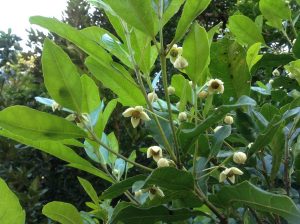Easy to overlook amongst the many trees in the rainforest, the Sloanea australis nevertheless draws attention when its fragrant, creamy white flowers bloom in September and October.
 Worldwide, there are about 120 species of Sloanea –named for British scientist and collector Hans Sloan, who lived 1660 to 1753. Four species are endemic to Australia with three of these growing in tropical rainforests in Queensland. Sloanea australis is distributed between the Windsor Tableland and Paluma. Several of these trees may be seen on Mount Spec Road near the Sensory Trail at Paluma Environmental Education Centre where they grow among the stand of forest trees bordering the school property.
Worldwide, there are about 120 species of Sloanea –named for British scientist and collector Hans Sloan, who lived 1660 to 1753. Four species are endemic to Australia with three of these growing in tropical rainforests in Queensland. Sloanea australis is distributed between the Windsor Tableland and Paluma. Several of these trees may be seen on Mount Spec Road near the Sensory Trail at Paluma Environmental Education Centre where they grow among the stand of forest trees bordering the school property.
The tree grows to 30 meters and may be buttressed. Bark is grey/brown, very lightly textured. The obovate, simple leaves are a glossy green with wavy margins and clearly defined veins. Flowers are dainty with 4 to 6 creamy white slightly fleshy petals, about 6 to 12 mm long. They grow, usually in a short raceme from the leaf axils. They are modest little flowers and easily lost amid all the dense green foliage.
The fruit is more easily detected, its red-coated seeds immediately attracting attention. Ripening around February/March, the fruit is a brown or orange, very bristly, three-valved capsule which splits to reveal three shiny black seeds, encased in a red aril, (or fleshy growth). Already tiny fruit can be seen; not yet much bigger than match-heads, their spiky skins are un-mistakable. The seeds are eaten by many bird species.
Sloanea australis is known by several common names: Maidens Blush, Blush Alder and Blush Carbeen. These names are derived from the colour of the tree’s heartwood which is a blushing pink.
Without flowers or fruit to guide you, it may be difficult to locate one of these trees but have a go! At least, in Spring or Summer, when you come across the flowers or fruit, you may remember to which tree they belong.
Text and photos by Colwyn Campbell
